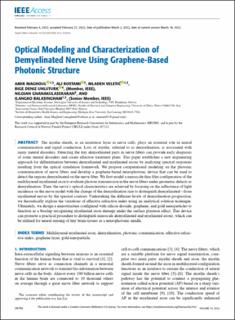| dc.contributor.author | Maghoul, Amir | |
| dc.contributor.author | Rostami, Ali | |
| dc.contributor.author | Veletic, Mladen | |
| dc.contributor.author | Unluturk, Bige Deniz | |
| dc.contributor.author | Gnanakulasekaran, Nilojan | |
| dc.contributor.author | Balasingham, Ilangko | |
| dc.date.accessioned | 2023-01-20T08:21:03Z | |
| dc.date.available | 2023-01-20T08:21:03Z | |
| dc.date.created | 2022-04-22T22:24:05Z | |
| dc.date.issued | 2022 | |
| dc.identifier.citation | IEEE Access. 2022, 10 28792-28807. | en_US |
| dc.identifier.issn | 2169-3536 | |
| dc.identifier.uri | https://hdl.handle.net/11250/3044792 | |
| dc.description.abstract | The myelin sheath, as an insulation layer in nerve cells, plays an essential role in neural communication and signal conduction. Loss of myelin, referred to as demyelination, is associated with many mental disorders. Detecting the tiny demyelinated parts in nerve fibers can provide early diagnosis of some mental disorders and create effective treatment plans. This paper establishes a new engineering approach for differentiation between demyelinated and myelinated axons by analyzing spectral responses resulting from the optical simulation framework. We propose computational modeling on the photonic communication of nerve fibers and develop a graphene-based neurophotonic device that can be used to detect the regions demyelinated on the nerve fiber. We first model a nanoscale thin-film configuration of the multilayered myelinated axon to evaluate photons transmission in the nerve fibers under geometric defects as demyelination. Then, the nerve’s optical characteristics are achieved by focusing on the reflectance of light incidence on the nerve model with the change of the demyelination size to distinguish demyelinated—from myelinated nerves by the spectral contrast. Undertaking the different levels of demyelination progression, we theoretically explore the variations of effective refractive index using an analytical solution technique. Ultimately, we design a nanostructure configured with silicon dioxide, graphene, and gold nanoparticles to function as a biochip recognizing myelinated axon damage under the surface plasmon effect. This device can promote a practical procedure to distinguish nanoscale demyelinated and myelinated axons, which can be utilized for neural sensing of tiny brain tissues as a neurophotonic needle. | en_US |
| dc.language.iso | eng | en_US |
| dc.publisher | IEEE | en_US |
| dc.rights | Navngivelse 4.0 Internasjonal | * |
| dc.rights.uri | http://creativecommons.org/licenses/by/4.0/deed.no | * |
| dc.title | Optical Modeling and Characterization of Demyelinated Nerve Using Graphene-Based Photonic Structure | en_US |
| dc.title.alternative | Optical Modeling and Characterization of Demyelinated Nerve Using Graphene-Based Photonic Structure | en_US |
| dc.type | Peer reviewed | en_US |
| dc.type | Journal article | en_US |
| dc.description.version | publishedVersion | en_US |
| dc.source.pagenumber | 28792-28807 | en_US |
| dc.source.volume | 10 | en_US |
| dc.source.journal | IEEE Access | en_US |
| dc.identifier.doi | 10.1109/ACCESS.2022.3156113 | |
| dc.identifier.cristin | 2018561 | |
| cristin.ispublished | true | |
| cristin.fulltext | postprint | |
| cristin.qualitycode | 1 | |

